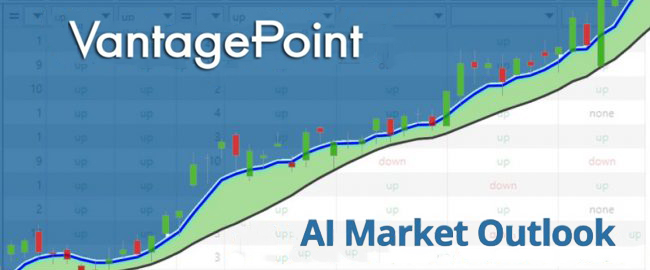In today’s article I’m going to do a deeper dive into understanding risk and the truth of options trading. I highly recommend all traders study options in depth because it increases the opportunity to minimize risk and reduce loss.
What got me hooked on learning options was when I discovered I could be 100% wrong on my assessment of the market and still make money. That realization was a significant change for me which completely altered my understanding of risk and opportunity for profit.
Here is the big picture perspective based upon market realities.
- Markets only trend 30% of the time
- Markets trade sideways, in choppy consolidation patterns 70% of the time
So, clearly there is a time one could make money with trending markets, but the majority of the time, we need to learn how to find opportunities in non-trending markets.
How do you find opportunities in a non-trending market? You must learn and master the art of selling time.
A few important points.
Options are deteriorating assets. This is a factual truth based upon the reality that an options premium or price is based upon the amount of time left in the options contract and the expected volatility of the asset by market participants.
When options are taught to beginners there are two points that are always emphasized. Those points are that whenever you purchase an option you have “limited risk” and “unlimited profit potential.” While these two factors are theoretically true, they are misleading.
I want you to imagine that you walk into a casino, and you stand by the roulette wheel watching others play. Gamblers are betting on the color red, or black, as well as individual numbers, odd, even or zero. You watch with amazement as people lay down their money to play. As the thousands of dollars change hands on each spin you have an interesting thought and ask yourself, “What is my probability of success in playing this game?” As soon as you begin to ponder that, you recognize you really don’t understand the game at all and instead you begin to analyze the activity from the perspective of the casino.
In other words, you start to ask what type of edge does the house have on each spin?
This analogy is very appropriate in learning options because when you trade options you quickly discover that you can be:
- The Gambler
- The Casino
- Both the gambler and the casino
Each one of these identities deploys a distinct set of tactics and strategies to minimize risk and increase the probability of profit.
Notice how I emphasized the term probability of profit and how this definition is completely different than the concept of “limited risk” and “unlimited profit potential” which are how options are traditionally taught.
To understand options, you must recognize what you are analyzing is TIME and volatility.
All options are priced according to how much time they have left and what the underlying volatility of the market is. This is vital to recognize because today there are hundreds of assets which trade weekly options expirations.
All options premiums consist of two variables.

Intrinsic Value is defined as what the option would be worth if today was the expiration date.
Extrinsic Value is also known as time value, is what the market is pricing the cost of time till the option expires.
Let’s look at an example:
XYZ stock is trading at $50 per share.
The $45 call option is trading at $6.
If today was the expiration date of the options, we could quickly determine that the INTRINSIC VALUE of a $45 call option is $5. This means that the Extrinsic Value of the option is $1. In other words, the market is pricing the remaining time in the options life at $1.
At options expiration, all options are only worth their Intrinsic Value.
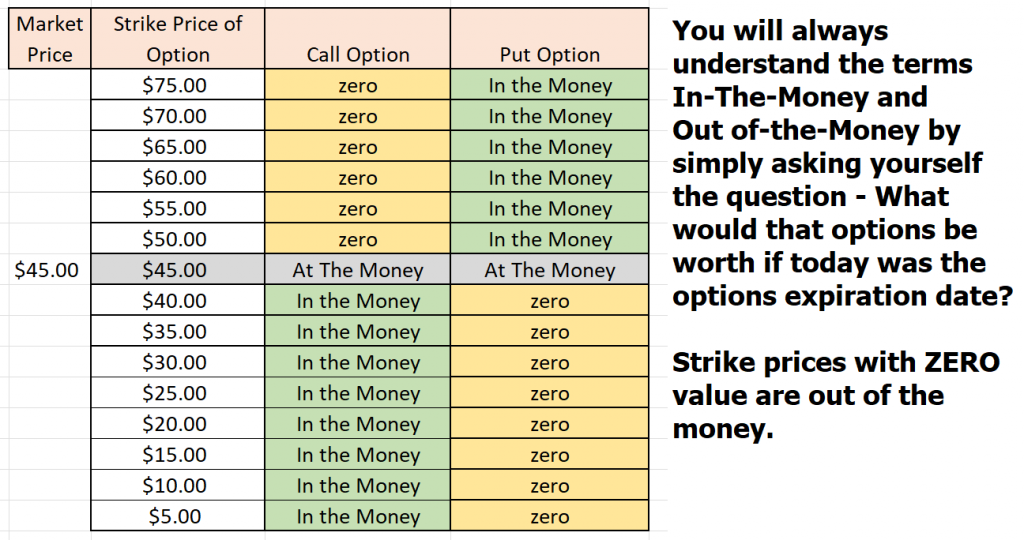
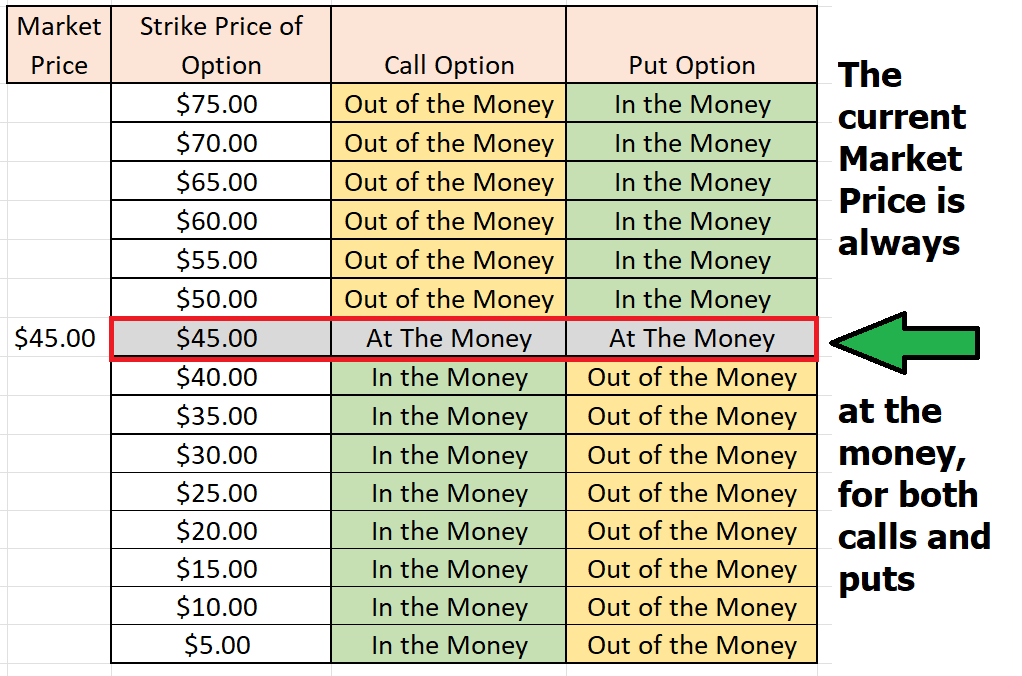
If an option has Intrinsic Value, it will always be in the money.
Any time you look at an options chain, you will be able to quickly determine how the market is pricing the cost of time.
My suggestion to understand this is to simply look at the at the money prices. All the money options only have Extrinsic Value (time value). This means if today was the expiration date the at the money option would expire worthless. More importantly, we can determine how quickly the option will decay and lose value over time by simply dividing the at the money premium by the number of days left in the option.
So, let’s say for purposes of discussion the $45 call at the money option is trading at $3 and there are only 10 days left till options expiration. We can deduce a few key facts from this information.
#1) The $3 premium for the at the money call should be divided by the remaining 10 days so we can determine how much time value will be lost each day. This amounts to $.30 per day in time decay. This is the cost of time!
If I put this in tabular format this is what the price of the option would be assuming stable, sideways pricing over the next 10 days.
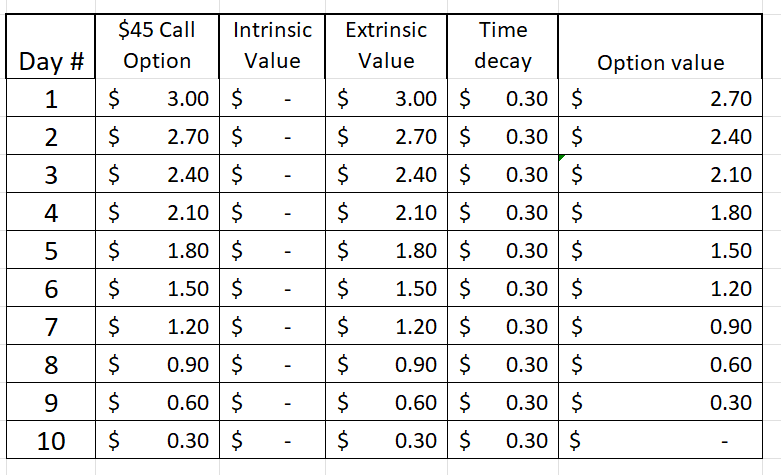
#2) A buyer of that call option needs the price of the underlying XYZ stock to be trading at $48 or higher at expiration for them to recover their entire cost of the option.
$45 strike price + $3 premium = $48 break even.
A $3 up move in a $45 stock equates to a 6.66% increase. A better analytical question is how often has the stock moved 6.66% in a 10-day period?
From these two important pieces of data, we can evaluate whether we should be looking at opportunities to buy time, sell time, or stand aside.
There are five outcomes of any trade.
- You make money if it moves up big
- You make money if it moves up a little
- You make money if it stays the same
- You make money if it moves down a little
- You make money if it moves down big
When you begin to analytically understand how the cost of time is factored into all options pricing you can create strategies and tactics because they are independent of price direction and trend and focused on time decay.
Let me share a few real-world examples, all with the benefit of 20/20 hindsight. The purpose of these examples is simply to challenge you when you look at any chart that you begin to be able to quickly determine which options strike prices have recently expired worthless. As you see that the Out of the Money options all expired worthless then you will quickly understand that even the In the Money options often lost value because of time decay.
Here is the chart of Carnival Cruise Lines ($CCL) over the past few months. Notice the narrow trading range. As you look at the chart simply ask yourself what strike price options have expired worthless? Recognize that even the in the money options which have expired, lost value because of time decay as well.
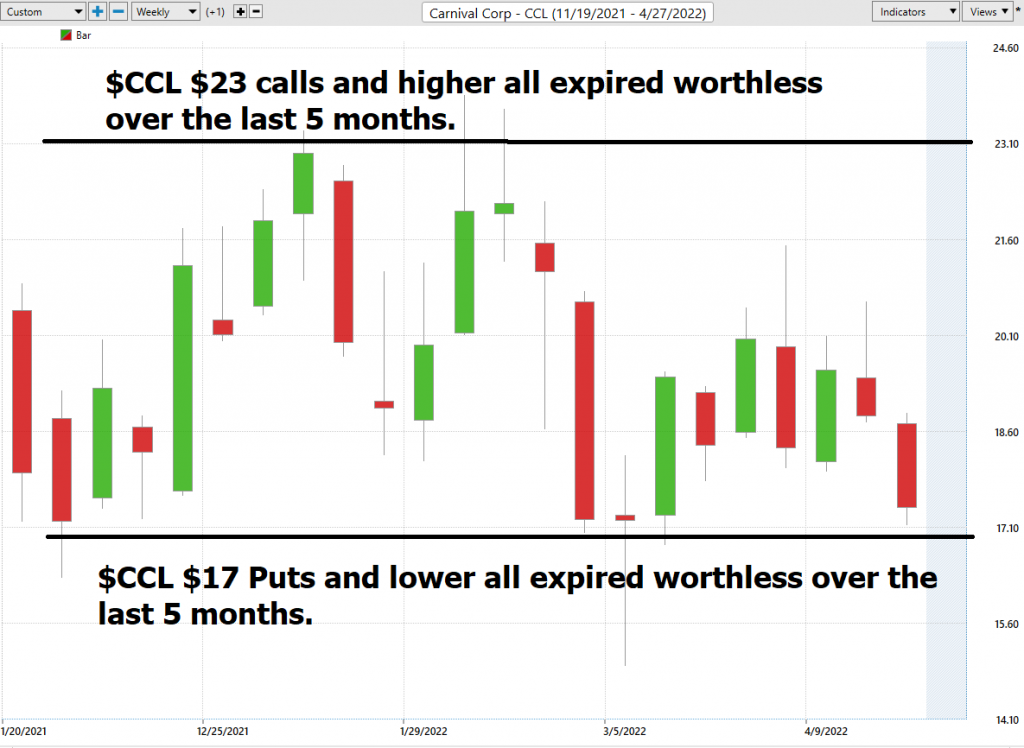
Here is the chart of Electronic Arts ($EA) on a Weekly basis. Same question, which option strike prices expired worthless over the duration of this chart?
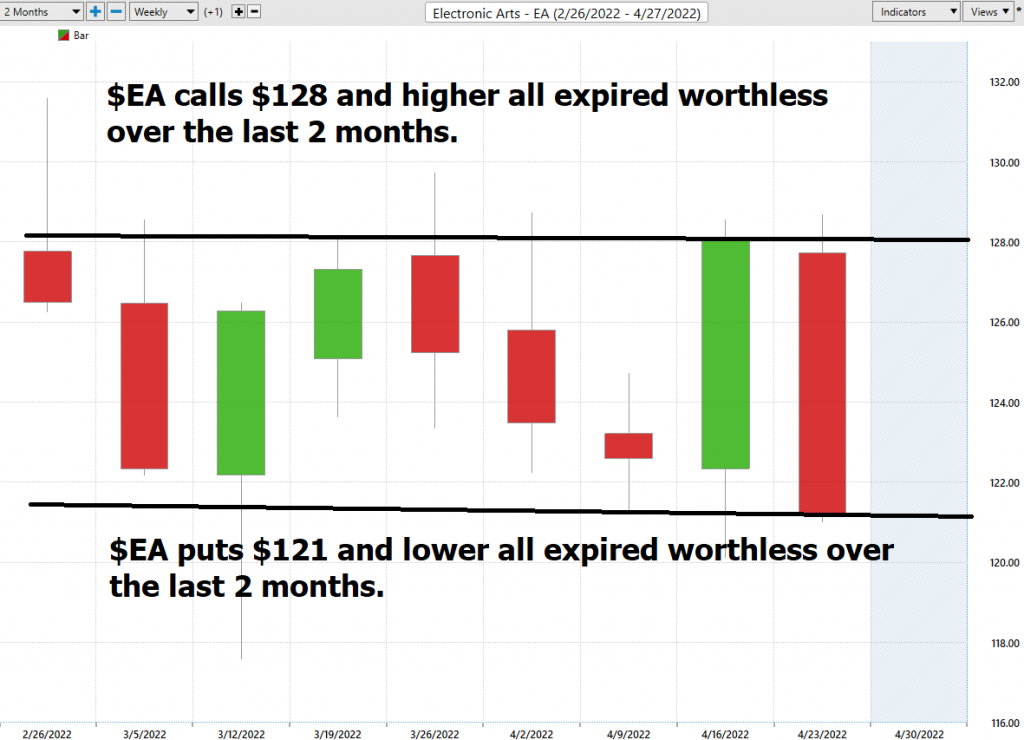
Both of the previous charts are examples of the 70% of the time when stock prices trade sideways.
This is not to say that you should never buy options. It could be appropriate to buy options when volatility is expected to increase. But even as an options buyer you ALWAYS need to be aware of the cost of TIME.
The sad truth of BUYING options is that when TIME is expensive you can be 100% right on market direction, but time decay will depreciate the value of the options faster than the trend is moving.
Here is a perfect example in the chart of Qualcomm ($QCOM). Notice how price has dropped 15% in the last 4 weeks. Had you been purchasing put options over the past few weeks as the market was trending downward, there is still a strong chance that you did not make money. Why? Because time decay was forcing the price of the options lower than the speed with which price was decreasing.
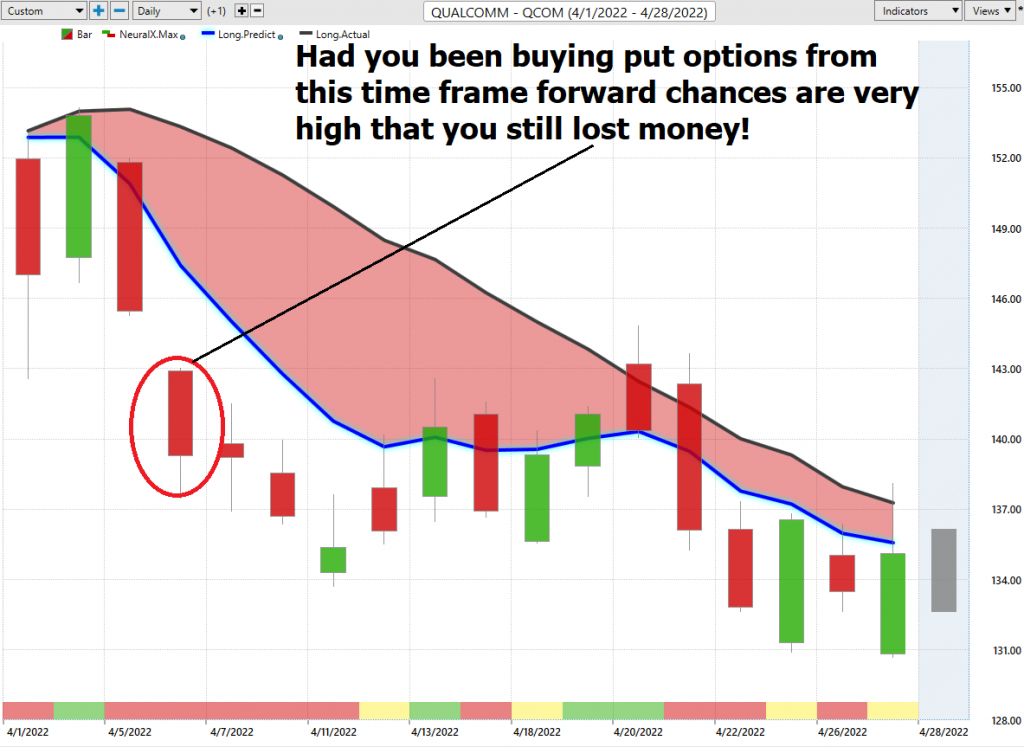
What is the alternative?
Look at the chart closely, particularly the slope of the blue and black lines. Notice how selling call options, or call credit spreads, with strike prices at the blue line/black line or higher was never seriously threatened. Any call option strike price at the black line or higher expired worthless.
This can be extremely powerful particularly as we approach options expiration because all options lose time value exponentially as they approach their expiration date.
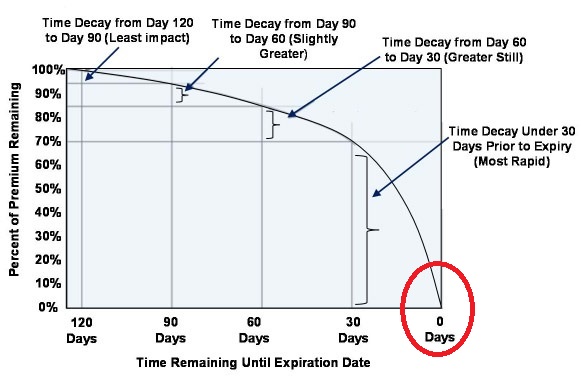
To assure that this is practical knowledge you need to test this out for yourself in a demo account. It is quite simple:
Look at any of the FAANG stocks. Facebook, Apple, Amazon, Nvidia, Google,
Then look at the At The money Calls and Put Options premiums one week away.
Hypothetically SELL both and collect the premium.
Simply watch how time decay affects the value of the options.
When you discover that you can be completely wrong in your forecast and still not lose money this is when you will recognize the power of options trading.
Newbies buy options and are always swinging for the fences. Professionals are always analyzing the cost of time. Hypothetically, when time is cheap you want to buy and when time is expensive you want to sell.
When you cross-reference this knowledge with effective trend analysis the probabilities are overwhelmingly in your favor. I refer to it as SELLING Time with the Trend.
The following chart illustrates this idea perfectly and it is all based on selling time going into a nearby options expiration.
When the slope of the predictive blue line is up, we look to sell puts, or put credit spreads going into expiration.
When the slope of the predictive blue line is down, in this exercise we would look to sell calls, or call credit spreads going into expiration.
The idea is twofold. Capture time decay + Minimize Risk. We always advise to always manage your risk on any trade with solid money management principles. Credit spreads are advisable.
What’s Your Best Chance in The Financial Markets Today?
The Answer A.I. offers will surprise you.
Today Artificial Intelligence, Machine Learning and Neural Networks are an absolute necessity in protecting your portfolio.
If you want to win, it’s all about who has the best tools.
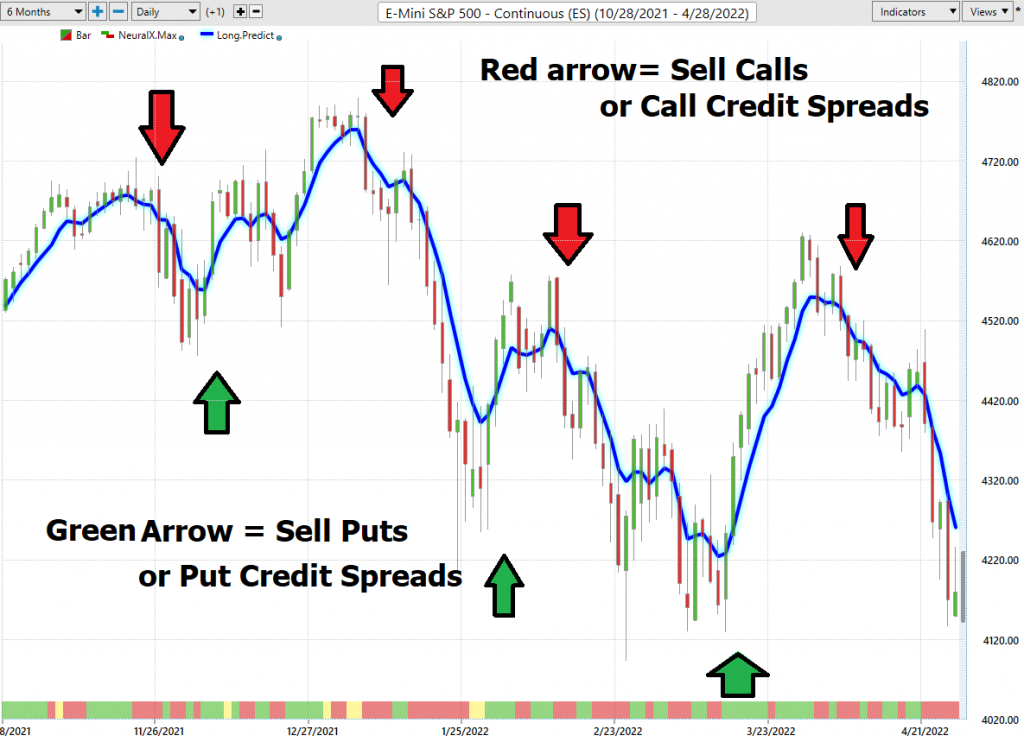
Everybody has had horrible trades. The difference between the winners and losers in life is that the winners learned immensely powerful lessons from their losses.
Artificial intelligence is so powerful because it learns what doesn’t work, remembers it, and then focuses on other paths to find a solution. This is the Feedback Loop that is responsible for building the fortunes of every successful trader I know.
Artificial Intelligence applies the mistake prevention as a continual process 24 hours a day, 365 days a year towards whatever problem it is looking to solve.
That should get you pretty excited because it is a game-changer.
Find the trend.
Scrutinize the 1–3-day forecast.
Lather. Rinse. Repeat.
The answer AI offers may surprise you.
This is how small traders grow their accounts by taking small bites out of the market consistently.
Today Artificial Intelligence, Machine Learning and Neural Networks are an absolute necessity in protecting your portfolio.
I, like everybody else, have my opinions about what will happen next. But I never let my opinion get in the way of what the artificial intelligence is forecasting.
Intrigued? Visit with us and check out the a.i. at our Next Live Training.
We’ll discuss strategies like this one and show you at least three stocks that have been identified by the A.I. that are poised for big movement
Discover why artificial intelligence is the solution professional traders go-to for less risk, more rewards, and guaranteed peace of mind.
It’s not magic. It’s machine learning.
Make it count!
THERE IS A SUBSTANTIAL RISK OF LOSS ASSOCIATED WITH TRADING. ONLY RISK CAPITAL SHOULD BE USED TO TRADE. TRADING STOCKS, FUTURES, OPTIONS, FOREX, AND ETFs IS NOT SUITABLE FOR EVERYONE.IMPORTANT NOTICE!
DISCLAIMER: STOCKS, FUTURES, OPTIONS, ETFs AND CURRENCY TRADING ALL HAVE LARGE POTENTIAL REWARDS, BUT THEY ALSO HAVE LARGE POTENTIAL RISK. YOU MUST BE AWARE OF THE RISKS AND BE WILLING TO ACCEPT THEM IN ORDER TO INVEST IN THESE MARKETS. DON’T TRADE WITH MONEY YOU CAN’T AFFORD TO LOSE. THIS ARTICLE AND WEBSITE IS NEITHER A SOLICITATION NOR AN OFFER TO BUY/SELL FUTURES, OPTIONS, STOCKS, OR CURRENCIES. NO REPRESENTATION IS BEING MADE THAT ANY ACCOUNT WILL OR IS LIKELY TO ACHIEVE PROFITS OR LOSSES SIMILAR TO THOSE DISCUSSED ON THIS ARTICLE OR WEBSITE. THE PAST PERFORMANCE OF ANY TRADING SYSTEM OR METHODOLOGY IS NOT NECESSARILY INDICATIVE OF FUTURE RESULTS. CFTC RULE 4.41 – HYPOTHETICAL OR SIMULATED PERFORMANCE RESULTS HAVE CERTAIN LIMITATIONS. UNLIKE AN ACTUAL PERFORMANCE RECORD, SIMULATED RESULTS DO NOT REPRESENT ACTUAL TRADING. ALSO, SINCE THE TRADES HAVE NOT BEEN EXECUTED, THE RESULTS MAY HAVE UNDER-OR-OVER COMPENSATED FOR THE IMPACT, IF ANY, OF CERTAIN MARKET FACTORS, SUCH AS LACK OF LIQUIDITY. SIMULATED TRADING PROGRAMS IN GENERAL ARE ALSO SUBJECT TO THE FACT THAT THEY ARE DESIGNED WITH THE BENEFIT OF HINDSIGHT. NO REPRESENTATION IS BEING MADE THAT ANY ACCOUNT WILL OR IS LIKELY TO ACHIEVE PROFIT OR LOSSES SIMILAR TO THOSE SHOWN.









